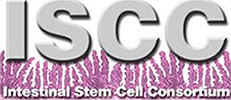Intestinal Stem Cell Consortium Coordinating Center

The Intestinal Stem Cell Consortium (ISCC) is a team-science initiative established by the National Institute of Diabetes and Digestive and Kidney Diseases (NIDDK) and the National Institute of Allergy and Infectious Diseases (NIAID) in 2009. The Consortium was renewed in 2014 for ISCC Generation 2 ("Gen 2") and again in 2019 for ISCC "Gen 3".
The ISCC Coordinating Center is housed at City of Hope in Duarte, California and the Research Projects are housed at 8 institutions across the nation:
- Baylor College of Medicine
- Cincinnati Children’s Hospital Medical Center (CCHMC)
- Columbia University
- Dana Farber Cancer Institute
- Stanford University
- Stowers Institute for Medical Research
- University of California, San Francisco (UCSF)
- University of Michigan
The Coordinating Center for the ISCC is housed in City of Hope’s Department of Diabetes & Cancer Discovery Science under the leadership of Joyce Niland, Ph.D., holder of the Estelle & Edward Alexander Chair in Information Sciences. Jessica Girard, M.P.H. serves as the Coordinating Center Program Manager and Carol Swanson serves as the Coordinating Center Associate.
Note: Previously funded Consortium institutions (2009 – 2014) were: Oregon Health & Science University, Stanford University, Stowers Institute for Medical Research, University of California Los Angeles School of Medicine (partnered with the VA Greater Los Angeles), University of North Carolina, Chapel Hill, University of Oklahoma Health Sciences Center, University of Pennsylvania and University of Pittsburgh.
Previously funded Consortium institutions from 2014 – 2019) were: Baylor College of Medicine, Cincinnati Children’s Hospital Medical Center, Columbia University, Dana Farber Cancer Institute, Stanford University, Stowers Institute for Medical Research, University of California Los Angeles (partnered with the VA Greater Los Angeles), University of California, San Francisco, and University of Michigan.
Vision, Mission Statement, and Goals
- Vision
The vision of the ISCC is to develop novel therapies targeting intestinal stem cells and their supportive niche to regenerate and rebuild the human intestine. - Mission
The mission of the ISCC is to characterize the minimal, required niche factors that support intestinal stem cells in health and disease, using an integrated, multidisciplinary team science approach. - ISCC Gen 3 Goals
The overarching goal of the Consortium is to characterize the minimal, required factors that support ISCs in health and disease, with the following sub-goals:- Similarities and differences between the murine and human ISC niche
- ISC niche function in homeostasis and injury
- Identification and validation of strategies to engineer the ISC niche for therapeutic purposes
Our Role
As the ISCC Coordinating Center, our overall objective is to provide optimal infrastructure and administrative support for the ISCC to ensure that the Consortium efficiently and rapidly achieves its goals.
Our Impact
ISCC-funded research:
- The current generation of ISCC investigators (‘Gen 3’, funded in 2019) engages approximately 135 individuals including principal and co-investigators, laboratory personnel, external consultants, National Institutes of Health and CC staff.
- ISCC investigators have published 239 manuscripts, in collaboration with co-authoring scientists, further expanding the reach and interactions of the ISCC.